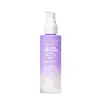What's inside
What's inside
 Key Ingredients
Key Ingredients

 Benefits
Benefits

 Concerns
Concerns

 Ingredients Side-by-side
Ingredients Side-by-side

Water
Skin ConditioningUrea
BufferingPersea Gratissima Oil
Skin ConditioningGlycerin
HumectantPolyglyceryl-3 Methylglucose Distearate
EmulsifyingIsopropyl Palmitate
EmollientOctyldodecanol
EmollientGlyceryl Stearate
EmollientCetyl Alcohol
EmollientPPG-3 Benzyl Ether Myristate
EmollientMyristyl Myristate
EmollientTriethyl Citrate
MaskingHydrolyzed Algin
Chlorella Vulgaris Extract
Skin ConditioningMaris Aqua
HumectantFarnesol
PerfumingHippophae Rhamnoides Extract
MaskingAllantoin
Skin ConditioningXanthan Gum
EmulsifyingPhenoxyethanol
PreservativeMethylparaben
PreservativeEthylparaben
PreservativeCaprylyl Glycol
EmollientPropylene Glycol
HumectantBHT
AntioxidantAscorbyl Palmitate
AntioxidantCitric Acid
BufferingWater, Urea, Persea Gratissima Oil, Glycerin, Polyglyceryl-3 Methylglucose Distearate, Isopropyl Palmitate, Octyldodecanol, Glyceryl Stearate, Cetyl Alcohol, PPG-3 Benzyl Ether Myristate, Myristyl Myristate, Triethyl Citrate, Hydrolyzed Algin, Chlorella Vulgaris Extract, Maris Aqua, Farnesol, Hippophae Rhamnoides Extract, Allantoin, Xanthan Gum, Phenoxyethanol, Methylparaben, Ethylparaben, Caprylyl Glycol, Propylene Glycol, BHT, Ascorbyl Palmitate, Citric Acid
Water
Skin ConditioningHelianthus Annuus Flower
Skin ConditioningAloe Barbadensis Leaf Juice
Skin ConditioningGlycerin
HumectantEthylhexyl Palmitate
EmollientGlyceryl Stearate
EmollientStearic Acid
CleansingGlyceryl Laurate
EmollientCeramide NP
Skin ConditioningCeramide AP
Skin ConditioningCeramide EOP
Skin ConditioningPhytosphingosine
Skin ConditioningCholesterol
EmollientPanthenol
Skin ConditioningPersea Gratissima Fruit Butter
EmollientTocopheryl Acetate
AntioxidantCalendula Officinalis Flower Extract
MaskingChamomilla Recutita Flower Extract
MaskingAlthaea Officinalis Flower Extract
EmollientSodium Hyaluronate
HumectantCocos Nucifera Fruit Juice
EmollientBeta-Glucan
Skin ConditioningAllantoin
Skin ConditioningTheobroma Cacao Seed Butter
EmollientXanthan Gum
EmulsifyingSodium Lauroyl Lactylate
EmulsifyingCarbomer
Emulsion StabilisingDiheptyl Succinate
EmollientCapryloyl Glycerin/Sebacic Acid Copolymer
Skin ConditioningPhenoxyethanol
PreservativeEthylhexylglycerin
Skin ConditioningWater, Helianthus Annuus Flower, Aloe Barbadensis Leaf Juice, Glycerin, Ethylhexyl Palmitate, Glyceryl Stearate, Stearic Acid, Glyceryl Laurate, Ceramide NP, Ceramide AP, Ceramide EOP, Phytosphingosine, Cholesterol, Panthenol, Persea Gratissima Fruit Butter, Tocopheryl Acetate, Calendula Officinalis Flower Extract, Chamomilla Recutita Flower Extract, Althaea Officinalis Flower Extract, Sodium Hyaluronate, Cocos Nucifera Fruit Juice, Beta-Glucan, Allantoin, Theobroma Cacao Seed Butter, Xanthan Gum, Sodium Lauroyl Lactylate, Carbomer, Diheptyl Succinate, Capryloyl Glycerin/Sebacic Acid Copolymer, Phenoxyethanol, Ethylhexylglycerin
 Reviews
Reviews

Ingredients Explained
These ingredients are found in both products.
Ingredients higher up in an ingredient list are typically present in a larger amount.
Allantoin is a soothing ingredient known for its protective and moisturizingg properties. Because of this, it is often added to products with strong active ingredients.
Studies show higher concentrations of this ingredient can promote wound healing.
Though it can be derived from the comfrey plant, allantoin is produced synthetically for cosmetic products to ensure purity.
Learn more about AllantoinGlycerin is already naturally found in your skin. It helps moisturize and protect your skin.
A study from 2016 found glycerin to be more effective as a humectant than AHAs and hyaluronic acid.
As a humectant, it helps the skin stay hydrated by pulling moisture to your skin. The low molecular weight of glycerin allows it to pull moisture into the deeper layers of your skin.
Hydrated skin improves your skin barrier; Your skin barrier helps protect against irritants and bacteria.
Glycerin has also been found to have antimicrobial and antiviral properties. Due to these properties, glycerin is often used in wound and burn treatments.
In cosmetics, glycerin is usually derived from plants such as soybean or palm. However, it can also be sourced from animals, such as tallow or animal fat.
This ingredient is organic, colorless, odorless, and non-toxic.
Glycerin is the name for this ingredient in American English. British English uses Glycerol/Glycerine.
Learn more about GlycerinGlyceryl Stearate is a mix of glycerin and stearic acid.
It is used to stabilize the mixing of water and oil ingredients. By preventing these ingredients from separating, it can help elongate shelf life. It can also help thicken the product's texture.
As an emollient, it helps soften skin and supports barrier-replenishing ingredients.
In cosmetics, Glyceryl Stearate is often made from vegetable oils or synthetically produced.
This ingredient may not be fungal-acne safe
Fun fact: The human body also creates Glyceryl Stearate naturally.
Learn more about Glyceryl StearatePhenoxyethanol is a preservative that has germicide, antimicrobial, and aromatic properties. Studies show that phenoxyethanol can prevent microbial growth. By itself, it has a scent that is similar to that of a rose.
It's often used in formulations along with Caprylyl Glycol to preserve the shelf life of products.
Water. It's the most common cosmetic ingredient of all. You'll usually see it at the top of ingredient lists, meaning that it makes up the largest part of the product.
So why is it so popular? Water most often acts as a solvent - this means that it helps dissolve other ingredients into the formulation.
You'll also recognize water as that liquid we all need to stay alive. If you see this, drink a glass of water. Stay hydrated!
Learn more about WaterXanthan gum is used as a stabilizer and thickener within cosmetic products. It helps give products a sticky, thick feeling - preventing them from being too runny.
On the technical side of things, xanthan gum is a polysaccharide - a combination consisting of multiple sugar molecules bonded together.
Xanthan gum is a pretty common and great ingredient. It is a natural, non-toxic, non-irritating ingredient that is also commonly used in food products.
Learn more about Xanthan Gum